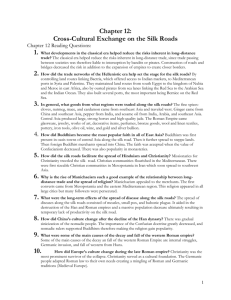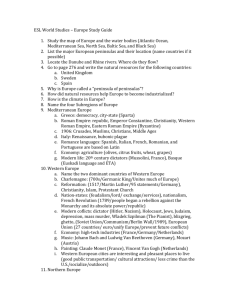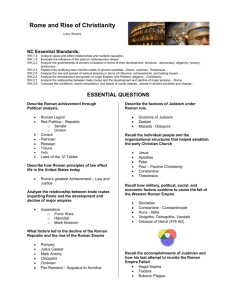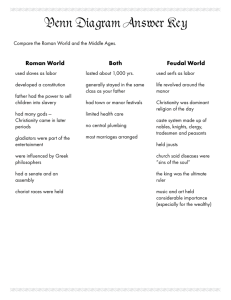AP World History Class Notes, Bentley Brief Edition Ch 9 Cross
advertisement
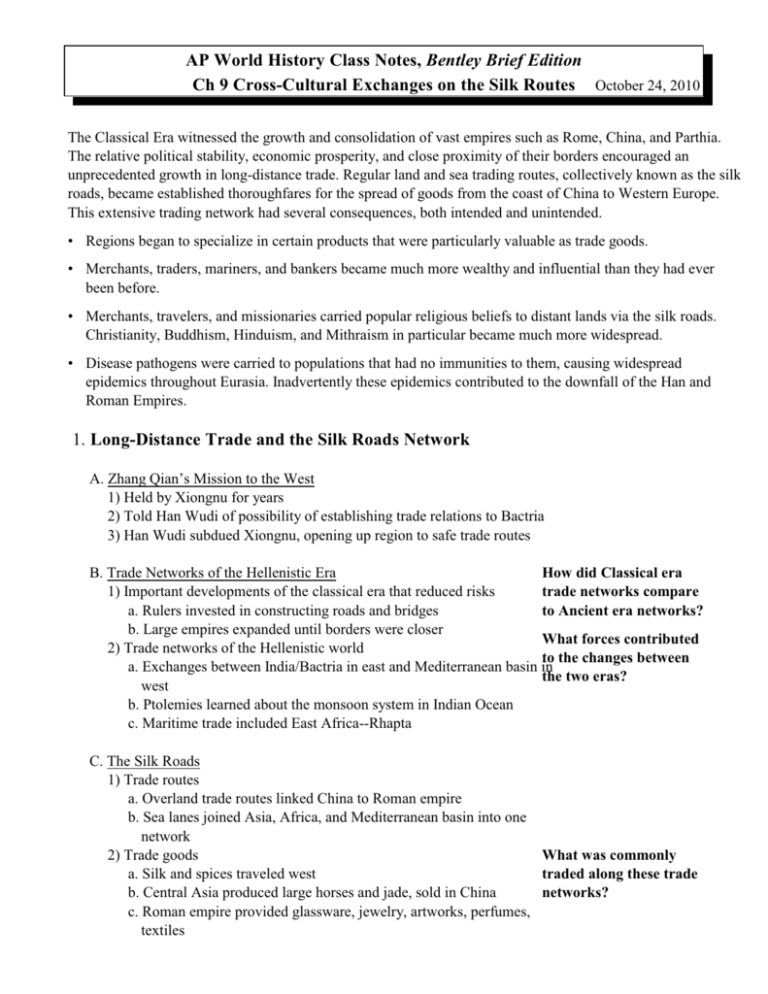
AP World History Class Notes, Bentley Brief Edition Ch 9 Cross-Cultural Exchanges on the Silk Routes October 24, 2010 The Classical Era witnessed the growth and consolidation of vast empires such as Rome, China, and Parthia. The relative political stability, economic prosperity, and close proximity of their borders encouraged an unprecedented growth in long-distance trade. Regular land and sea trading routes, collectively known as the silk roads, became established thoroughfares for the spread of goods from the coast of China to Western Europe. This extensive trading network had several consequences, both intended and unintended. • Regions began to specialize in certain products that were particularly valuable as trade goods. • Merchants, traders, mariners, and bankers became much more wealthy and influential than they had ever been before. • Merchants, travelers, and missionaries carried popular religious beliefs to distant lands via the silk roads. Christianity, Buddhism, Hinduism, and Mithraism in particular became much more widespread. • Disease pathogens were carried to populations that had no immunities to them, causing widespread epidemics throughout Eurasia. Inadvertently these epidemics contributed to the downfall of the Han and Roman Empires. 1. Long-Distance Trade and the Silk Roads Network A. Zhang Qian’s Mission to the West 1) Held by Xiongnu for years 2) Told Han Wudi of possibility of establishing trade relations to Bactria 3) Han Wudi subdued Xiongnu, opening up region to safe trade routes B. Trade Networks of the Hellenistic Era How did Classical era 1) Important developments of the classical era that reduced risks trade networks compare a. Rulers invested in constructing roads and bridges to Ancient era networks? b. Large empires expanded until borders were closer What forces contributed 2) Trade networks of the Hellenistic world to the changes between a. Exchanges between India/Bactria in east and Mediterranean basin in the two eras? west b. Ptolemies learned about the monsoon system in Indian Ocean c. Maritime trade included East Africa--Rhapta C. The Silk Roads 1) Trade routes a. Overland trade routes linked China to Roman empire b. Sea lanes joined Asia, Africa, and Mediterranean basin into one network 2) Trade goods What was commonly a. Silk and spices traveled west traded along these trade b. Central Asia produced large horses and jade, sold in China networks? c. Roman empire provided glassware, jewelry, artworks, perfumes, textiles 2 AP World History Class Notes, Bentley Brief Edition Ch 9 Cross-Cultural Exchanges on the Silk Routes October 24, 2010 3) The organization of long-distance trade a. Merchants of different regions handled long-distance trade in stages b. On the seas, long-distance trade was dominated by different empires 2. Cultural and Biological Exchanges Along the Silk Roads A. The Spread of Buddhism and Hinduism 1) Buddhism in central Asia and China a. 1st present in oasis towns of central Asia along silk roads b. Further spread to steppe lands c. Foreign merchants as Buddhists in China, 1st century BCE d. Popularity of monasteries and missionaries, 5th century CE 2) Buddhism and Hinduism in SE Asia Besides physical goods, what intangibles also traveled along trade networks? How and where did Buddhism spread by 600 CE ? B. The Spread of Christianity How and where did 1) Christianity in the Mediterranean basin Christianity spread by a. Missionaries, like Gregory the Wonderworker, attracted converts 600 CE ? b. Christian communities flourished in Mediterranean basin by late 3rd century CE 2) Christianity in Southwest Asia followed the trade routes a. Sizable communities in Mesopotamia and Iran, 2nd century CE b. Sizable number of converts in SW Asia until the 7th century CE c. Their ascetic practices influenced Christian practices in the Roman empire d. Nestorians emphasized human nature of Jesus, 5th century CE e. Nestorian communities in central Asia, India, and China by 7th century CE C. The Spread of Manichaeism; Best Example of Religion Spread on Silk How did religions spread Roads along trade networks, 1) Mani and Manichaeism and how did the trade a. Prophet Mani, a Zoroastrian, drew influence from Christianity andnetworks affect the Buddhism religions? b. Dualism: perceived a cosmic struggle between light and darkness, good and evil c. Offered means to achieve personal salvation d. Ascetic lifestyle and high ethical standards e. Differentiation between the “elect” and the “hearers” 2) Spread of Manichaeism; appealed to merchants a. Attracted converts 1st in Mesopt. & E Mediterranean region b. Appeared in all large cities of Roman empire, 3rd century CE 3) Persecuted by Sasanids and Romans but survived in central Asia 3 AP World History Class Notes, Bentley Brief Edition Ch 9 Cross-Cultural Exchanges on the Silk Routes October 24, 2010 D. The Spread of Epidemic Disease What effects did 1) Epidemic diseases diseases have on a. Common epidemics in Rome and China: smallpox, measles, bubonic Classical empires? plague b. Roman empire: population dropped by 25% from t1st-10th century CE c. China: population dropped by 25% from the 1st to 7th century CE 2) Effects of epidemic diseases a. Both Chinese and Roman economies contracted b. Small regional economies emerged c. Epidemics weakened Han and Roman empires 3. China After the Han Dynasty A. Internal Decay of the Han State 1) Problems of factions and land distribution led to rebellions 2) Generals usurped political authority; the emperor became a puppet a. By 220 CE , generals abolished the Han, divided the empire into 3 kingdoms b. Nomadic peoples came in; China became even more divided for 350 years What caused Classical Empires to decline, collapse, or transform into something else? B. Cultural Change in Post-Han China 1) Gradual sinicization of nomadic peoples 2) Withering of Confucianism in light of political instability 3) Popularity of Buddhism; nomadic rulers embraced it What were the environmental and social weaknesses of Classical Empires? 4. The Fall of the Roman Empire A. Internal Decay in the Roman Empire 1) Barracks emperors: series of generals seizing throne (235-284 CE ) 2) The emperor Diocletian (284-305 CE ) a. Divided the empire into two administrative districts b. A co-emperor ruled each district with the aid of a powerful lieutenant (the “tetrarchs”) 3) The emperor Constantine and new capital Constantinople What external (foreign) weaknesses contributed to the end of Classical Empires? B. Germanic Invasions and the Fall of the Western Roman Empire 1) Germanic migrations from northern Europe to eastern and northern part of Roman empire a. Visigoths--settled agriculturalists; adopted Roman law and Christianity b. Roman authorities kept Germanic peoples on the borders as a buffer 4 AP World History Class Notes, Bentley Brief Edition Ch 9 Cross-Cultural Exchanges on the Silk Routes October 24, 2010 2) The Huns under Attila attacked Europe mid-5th century CE 3) The collapse of the western Roman empire a. Under the Huns’ pressure, Germanic peoples streamed into the Roman empire b. Established settlements in Italy, Gaul, Spain, Britain, & N Africa c. Germanic general Odovacer deposed the Roman emperor, 476 CE d. Imperial authority survived in the eastern half of the empire (Byzantium) C. Cultural Change in the Late Roman Empire 1) Christianity most prominent survivor of the collapse of the empire a. With Constantine’s Edict of Milan, Christianity became a legitimate religion, 313 CE b. Emperor Theodosius proclaimed Christianity the official religion, 380 CE c. St. Augustine (“baptized” Plato) harmonized Christianity with Platonic thought 2) The Church became increasingly institutionalized a. Conflicting doctrines and practices among early Christians b. Established standardized hierarchy of church officials c. The “Bishop of Rome,” known as the Pope, became spiritual leader d. As Roman empire collapsed, Christianity served as a cultural foundation

